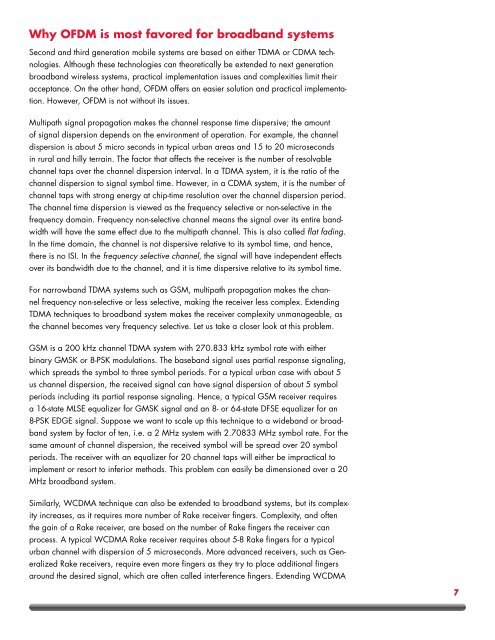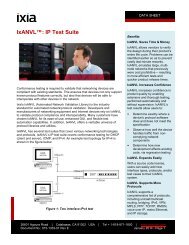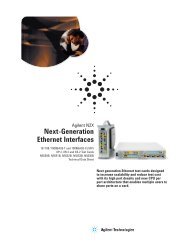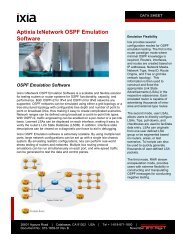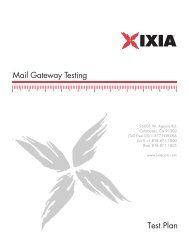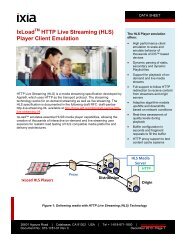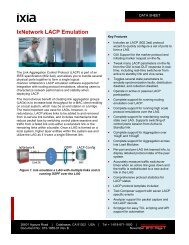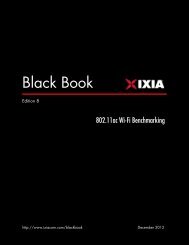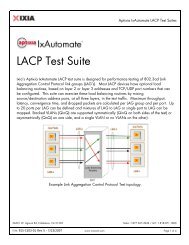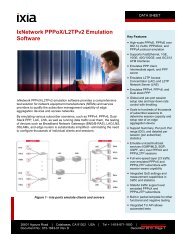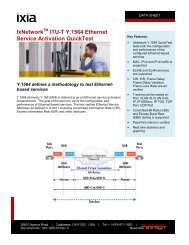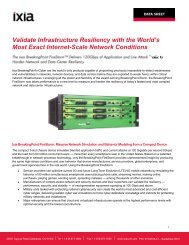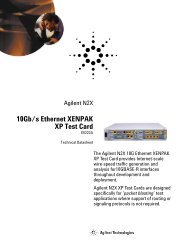SC-FDMA Single Carrier FDMA in LTE - Ixia
SC-FDMA Single Carrier FDMA in LTE - Ixia
SC-FDMA Single Carrier FDMA in LTE - Ixia
- No tags were found...
Create successful ePaper yourself
Turn your PDF publications into a flip-book with our unique Google optimized e-Paper software.
Why OFDM is most favored for broadband systemsSecond and third generation mobile systems are based on either TDMA or CDMA technologies.Although these technologies can theoretically be extended to next generationbroadband wireless systems, practical implementation issues and complexities limit theiracceptance. On the other hand, OFDM offers an easier solution and practical implementation.However, OFDM is not without its issues.Multipath signal propagation makes the channel response time dispersive; the amountof signal dispersion depends on the environment of operation. For example, the channeldispersion is about 5 micro seconds <strong>in</strong> typical urban areas and 15 to 20 microseconds<strong>in</strong> rural and hilly terra<strong>in</strong>. The factor that affects the receiver is the number of resolvablechannel taps over the channel dispersion <strong>in</strong>terval. In a TDMA system, it is the ratio of thechannel dispersion to signal symbol time. However, <strong>in</strong> a CDMA system, it is the number ofchannel taps with strong energy at chip-time resolution over the channel dispersion period.The channel time dispersion is viewed as the frequency selective or non-selective <strong>in</strong> thefrequency doma<strong>in</strong>. Frequency non-selective channel means the signal over its entire bandwidthwill have the same effect due to the multipath channel. This is also called flat fad<strong>in</strong>g.In the time doma<strong>in</strong>, the channel is not dispersive relative to its symbol time, and hence,there is no ISI. In the frequency selective channel, the signal will have <strong>in</strong>dependent effectsover its bandwidth due to the channel, and it is time dispersive relative to its symbol time.For narrowband TDMA systems such as GSM, multipath propagation makes the channelfrequency non-selective or less selective, mak<strong>in</strong>g the receiver less complex. Extend<strong>in</strong>gTDMA techniques to broadband system makes the receiver complexity unmanageable, asthe channel becomes very frequency selective. Let us take a closer look at this problem.GSM is a 200 kHz channel TDMA system with 270.833 kHz symbol rate with eitherb<strong>in</strong>ary GMSK or 8-PSK modulations. The baseband signal uses partial response signal<strong>in</strong>g,which spreads the symbol to three symbol periods. For a typical urban case with about 5us channel dispersion, the received signal can have signal dispersion of about 5 symbolperiods <strong>in</strong>clud<strong>in</strong>g its partial response signal<strong>in</strong>g. Hence, a typical GSM receiver requiresa 16-state MLSE equalizer for GMSK signal and an 8- or 64-state DFSE equalizer for an8-PSK EDGE signal. Suppose we want to scale up this technique to a wideband or broadbandsystem by factor of ten, i.e. a 2 MHz system with 2.70833 MHz symbol rate. For thesame amount of channel dispersion, the received symbol will be spread over 20 symbolperiods. The receiver with an equalizer for 20 channel taps will either be impractical toimplement or resort to <strong>in</strong>ferior methods. This problem can easily be dimensioned over a 20MHz broadband system.Similarly, WCDMA technique can also be extended to broadband systems, but its complexity<strong>in</strong>creases, as it requires more number of Rake receiver f<strong>in</strong>gers. Complexity, and oftenthe ga<strong>in</strong> of a Rake receiver, are based on the number of Rake f<strong>in</strong>gers the receiver canprocess. A typical WCDMA Rake receiver requires about 5-8 Rake f<strong>in</strong>gers for a typicalurban channel with dispersion of 5 microseconds. More advanced receivers, such as GeneralizedRake receivers, require even more f<strong>in</strong>gers as they try to place additional f<strong>in</strong>gersaround the desired signal, which are often called <strong>in</strong>terference f<strong>in</strong>gers. Extend<strong>in</strong>g WCDMA7


